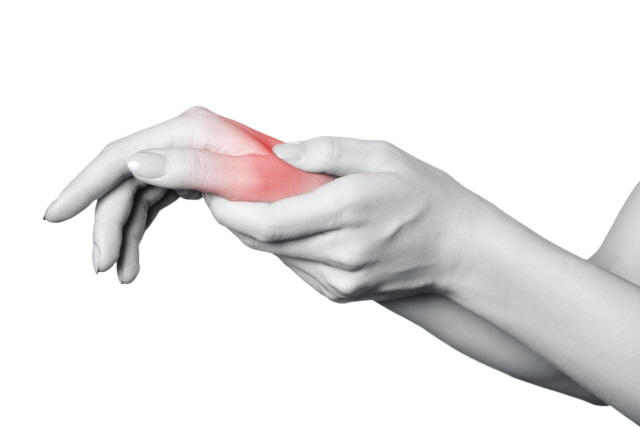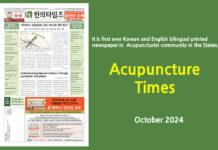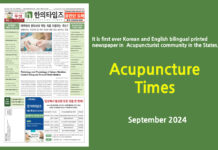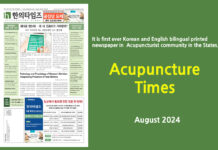
Carpal tunnel syndrome: symptom, causing factors, treatment strategies
By Namwook Cho L.Ac.
Carpal tunnel syndrome is commonly seen in an acupuncture clinic. It seems that as more people work with computers and use more hands to control cell phones, the prevalence of the symptom increases.
The problem is that people with pain cannot stop using their painful wrists while working with computers in most cases, which puts acupuncturists in a dilemma.
Let’s find valuable information to fight our dilemma more efficiently from Korean national guidelines to treat carpal tunnel syndrome.
According to the Clinical Practice Guideline of Korean Medicine, the symptoms are majorly due to cold dampness, phlegm, and stagnation of dampness heat and phlegm. The guideline shows the most effective and scientifically proven methods by acupuncture treatments and herbal medicine formulas for various etiology of the symptom.
Definition and Understanding
Carpal tunnel syndrome is a peripheral neuropathy of the median nerve entrapment caused by the thickening of the transverse carpal ligament.
Its occurrence in females is approximately five times higher than in males, and the incidence rate is high in the 40 to 74 age group.
Anatomy of the wrist
The carpal bones around the wrist joint form a 凹-shaped surface. The transverse carpal ligament covers the upper part of this 凹-shaped surface. The carpal tunnel is the space between the transverse carpal ligament and the carpal bones.
Supposing the interior space of the carpal tunnel decreases, or the volume of other compartments in the carpal tunnel increases, the pressure on the tissues inside the carpal tunnel increases. The decreased space can increase the pressure load on the median nerve and lead to carpal tunnel syndrome.
Cause of the symptom
The cause of carpal tunnel syndrome is unclear, but excessive use of the wrist and wrist trauma are the main contributing factors. Some activities that can lead to carpal tunnel syndrome include washing dishes, driving, mopping, knitting, typing, and painting.
Distal radius fracture malunion, hand burn, infections and edema, tumor, radial artery latency, carpal bone fracture, or dislocations from trauma can also cause carpal tunnel syndrome. Moreover, systemic complications such as pregnancy, obesity, hemodialysis, and rheumatoid arthritis can lead to carpal tunnel syndrome.
Treatment guidelines
- Acupuncture B/Moderate: Acupuncture should be considered to improve symptoms and functionality in adult patients with carpal tunnel syndrome.
Clinical considerations: As performing acupuncture therapy, the focus should be on regions crossed by the median nerve, such as the PC7 and PC6 meridians and symptomatic regions, such as the PC8, LI4, LU10, and EX-UE9 meridians. The needle should remain for 15 to 30 minutes during acupuncture therapy. According to the literature, treatment 2 to 3 times a week for about four weeks, a total of 8 to 12 times, showed a significant effect.
- AcupotomyB/Moderate: Acupotomy should be considered to improve symptoms and functionality in adult patients with carpal tunnel syndrome.
Clinical considerations: Acupotomy should aim for the PC7 meridian region around the transverse carpal ligament and be performed weekly for about three weeks.
- Electroacupuncture B/Moderate: Electroacupuncture should be considered to improve symptoms and functionality in adult patients with carpal tunnel syndrome.
Clinical considerations: When performing electroacupuncture, regions traveled by the median nerves, such as the PC7 and PC6 meridians; symptomatic regions, such as the PC8, LI4, LU10, and EXUE9 meridians; and meridians located in the directions of the hand, such as LI10, TE5, LU5, HT3, and PC3 can be selected as the acupoints. The electrical stimulus is recommended to be 1 to 2Hz and performed 20 minutes a day, twice a week, for 16 times in 8 weeks.
- Laser acupuncture A/High: Laser acupuncture is recommended to improve symptoms and functionality in adult patients with carpal tunnel syndrome.
Clinical considerations: Laser acupuncture should aim for regions crossed by the median nerves, such as PC6 and PC7 meridians. It can also be performed in the meridians of the symptomatic regions regarding the acupoints of acupuncture therapy, such as PC8, TE5, and HT7, and ear acupuncture. Generally, a low-level infrared laser is used. According to the literature, a laser with an output of 150mW and wavelength of 810nm applied for 5min per acupoint or a laser with an output of 400mW and wavelength of 810nm applied for 1min per acupoint five times a week for four weeks is reported to be significantly effective.
- Cupping C/Low: Cupping is the least recommended.
- Acupuncture & Herbal medicine A/High: Combining acupuncture and herbal medicine is recommended to improve symptoms and functionality in adult patients with carpal tunnel syndrome.
Clinical considerations: According to the literature, acupuncture therapy on meridians such as PC7, PC6, LI4, LI11, LI10, LU10, and PC8, 20 to 30 minutes a day for three weeks, in a total of 8 times, and using Hwanggigyejiomul-tang (黃芪桂枝五物湯) twice a day for three weeks showed a significant effect. Boyanghwano-tang (補陽還五湯), Sintongchukeatang (身痛縮瘀湯), Hwanggigyejiomul-tang (黃芪桂枝五物湯), Yiggihwalhyul-tang (益氣活血湯), etc. are commonly used.
































